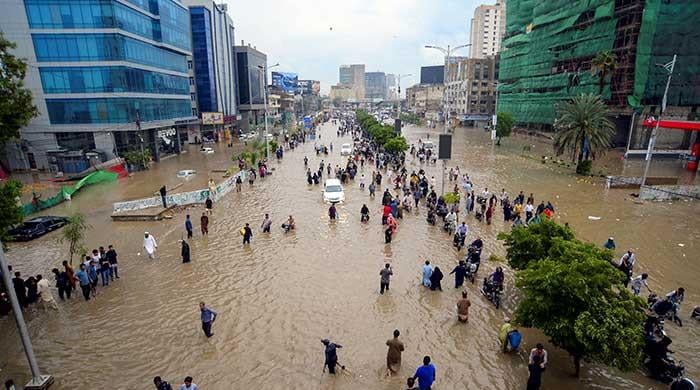Entertainment
How can we save Karachi?

The recent torrential rains — about 200 millimetres in three days — have once again exposed the chaotic and fragmented governance of Karachi. Flooding revived the confusion over which agency or municipal body is responsible for basic services, further fuelling public frustration and intensifying debates about how the city is governed.
Across the border in Mumbai, nearly 800 millimetres of rain over just four days disrupted the lives of millions, flooding roads, grounding flights, and halting train services, while large parts of the city lay submerged in waist-deep water.
Yet the comparison is striking: both cities endure the same climate shocks, but Mumbai absorbs the impact and recovers, whereas Karachi repeatedly falters. The contrast underscores a deeper reality — governance, financial capacity and urban planning make all the difference.
Karachi’s ongoing liveability crisis is highlighted by its ranking as the fourth least liveable city in the world, 170th out of 173 cities, in the 2025 Economist Intelligence Unit’s Global Liveability Index. By contrast, Mumbai stands at 121st, reflecting somewhat better, though still challenging, urban conditions.
Karachi and Mumbai are megacities of more than 20 million people. But while Mumbai has built stronger urban institutions, Karachi has been systematically weakened by political fragmentation and wilful neglect. The results are visible everywhere: in collapsing infrastructure, inadequate services, and declining quality of life.
The financial contrast is glaring. The Brihanmumbai Municipal Corporation’s 2024–25 budget is INR26,835 crore, about $3.2 billion. That equals $160 per person for a population of roughly 20 million. Nearly 76% of this revenue is raised locally — through property taxes, utility fees, and development charges — with the remainder from Maharashtra state transfers, including INR9,984 crore in octroi compensation.
This robust base allows Mumbai to keep investing in infrastructure and services year after year. Karachi, by comparison, is struggling.
The Karachi Metropolitan Corporation’s 2025–26 budget is Rs55 billion — just $196 million. Adding in other municipal agencies, cantonments, DHA and provincial departments, citywide spending is estimated at only $300 million to $500 million, though a lack of transparency makes it difficult to get a clear fiscal picture of the entire city.
For a population of 20 million, this translates to just $14.7 to $25 per person annually — six to eleven times less than Mumbai. Such chronic underfunding results in failing services, crumbling roads and water that never reaches millions of homes.
Mumbai’s suburban railway illustrates what serious urban planning can achieve. It runs across 450 kilometres of track, operates over 2,300 daily train services, and carries more than 7.5 million passengers every day. Karachi, in contrast, has nothing comparable. The city depends on decrepit buses, minibuses, rickshaws and vans — all overcrowded and unreliable.
The Sindh government has promised 8,000 electric buses, but actual delivery has barely begun. The Karachi Breeze Bus Rapid Transit project has been mired in delays.
Construction of the Green Line started in 2016, yet it was only partially opened in 2021 after funding gaps, bureaucratic hold-ups and the pandemic. For a city of this scale, the absence of functional mass transit is crippling.
Karachi’s financial and service woes are worsened by chaotic urban planning.
It has become a concrete jungle marked by rampant corruption, unchecked real-estate development and the absence of a robust local government system. Adding to the city’s planning failures, the Karachi Building Control Authority (KBCA), responsible for regulating construction and enforcing safety codes, has long been plagued by incompetence, corruption and weak enforcement. A tragic example came in July 2025, when a five-storey building in Lyari collapsed, killing 27 people.
The DHA and cantonment boards control the affluent zones — DHA spans about 36 square kilometres (1% of Karachi), Malir Cantonment about 12 square kilometres — with the six cantonments and DHA together managing 20–30% of the city.
The PPP-led Sindh government, in power since 2008, oversees the remaining 70–80%, where 17 million of Karachi’s 20 million residents live (according to the Karachi Water & Sewerage Corporation’s website). It bears the main responsibility for the city’s chronic failures and developmental decay.
Fragmentation undermines governance at its core. Each municipal or cantonment body operates independently, with little coordination to enable economies of scale, shared investments or strategic planning. The result is duplicated duties, conflicting priorities and weak accountability. Many describe Karachi’s fragmented governance as little more than the division of territory among powerful stakeholders.
Karachi’s underrepresentation in politics adds to this neglect. The city elects 22 of Pakistan’s 266 National Assembly members (8.3%) on general seats, and 47 of Sindh’s 130 provincial assembly members on general seats (36.1%), yet it holds only two federal cabinet seats (out of 43) and two provincial ministries (out of 18). The imbalance reduces Karachi’s influence in decisions about budgets and reforms, despite its economic weight and demographic importance.
The city’s failures are most visible in water. The Karachi Water & Sewerage Corporation supplies around 423 million gallons per day, barely one third of the required 1,080 – 1,200 MGD. This gap forces dependence on over 10,000 water tankers, many controlled by a “tanker mafia” accused of siphoning off an estimated 272 MGD, or 41% of the city’s supply. Karachi also loses 30 — 40% of piped water through leaks from an ageing network, some of it dating back to the 1950s.
Beyond water, Karachi suffers every day from gridlocked traffic, collapsed waste management and inadequate storm drainage that leads to floods with each monsoon. Climate risks compound these crises: heatwaves and intense storms increasingly threaten millions of residents. Informal settlements, where basic infrastructure is absent, are hit hardest.
In stark contrast, Mumbai demonstrates how strong institutions, financial autonomy and political empowerment support resilience. Its ability to raise significant local revenue, while also drawing state resources, sustains continuous investment in services. The lesson is clear: coherent governance and empowered local bodies are crucial to urban survival and growth.
Karachi, however, is governed by a model resembling urban apartheid. Affluent neighbourhoods enjoy superior services and infrastructure, while mostly middle – and lower-income areas face relentless decay and neglect under the Sindh provincial government.
The Clifton Bridge, widely seen as both a physical and symbolic divide, separates these privileged enclaves from the rest of the city. While around 380,000 residents live south of the bridge, 98% reside beyond it, highlighting a stark boundary between privilege and neglect that underscores the deep socio-economic segregation fracturing Karachi’s urban fabric.
The path forward demands urgent reform. Karachi must unify its fragmented municipal and cantonment authorities into a single metropolitan body to enable strategic planning, reduce waste and improve services. Strengthening local revenue collection is essential. Bold investments are needed, especially to rehabilitate water pipelines and dismantle exploitative cartels like the tanker mafia.
The World Bank’s 2018 Karachi City Diagnostic estimated nearly $10 billion in capital investment over a decade to close critical gaps in transport, water, sanitation and waste management — key to making Karachi liveable and economically competitive.
As Pakistan’s economic backbone, Karachi’s future is at serious risk. Decades of neglect, dysfunction and underfunding have brought the city to the brink. Without bold reforms, increased funding and unified governance, Karachi faces collapse — crumbling infrastructure, rising inequality and growing unrest.
Realising its potential requires political will, competent leadership and a national commitment to save a city Pakistan cannot afford to lose.
Disclaimer: The viewpoints expressed in this piece are the writer’s own and don’t necessarily reflect Geo.tv’s editorial policy.
The writer is former head of Citigroup’s emerging markets investments and author of ‘The Gathering Storm’.
Originally published in The News
Entertainment
‘Stranger Things’ Jamie Campbell Bower on Vecna transformation: ‘Hideous’

Vecna, there’s a lot of talk about the character’s makeover in the new season of Stranger Things, and it didn’t take long for fans to notice that something has changed.
Jamie Campbell Bower has returned as the terrifying villain in the first volume of season five, and viewers were quick to point out his sharpened look, especially that slim waist.
One fan on X asked why Vecna appeared so different this time around, pointing out the “branches on his shoulder” and “slimmer waist.”
Jamie didn’t miss the chance to keep things light, replying with one word: “Zumba.”
After being nearly burned alive by Nancy Wheeler at the end of season four, the villain formerly known as Henry Creel is back in Hawkins with longer vines across his shoulders and head, and visible marks from the injuries he sustained.
While still large and imposing, his new appearance is much leaner than before.
For Jamie, the changes are tied to Vecna’s journey and what he has endured.
Speaking about the transformation in an interview with Screen Rant, he said, “Well, as we saw at the end of season four, Vecna suffered a fall and obviously was sort of almost burned alive. My understanding of it is that the reason he looks the way he does now is a byproduct of partly of that process. And also, just having spent more time, not in the human world as it were.”
Jamie continued, “He’s become more resentful and hideous within that process and part of the world in which he was thrown into.”
He also explained that stepping into this evolved version of the character took even more work behind the scenes.
“I speak about this often,” he said, adding that extra pieces were added to the suit to bring his presence to life. The makeup alone took around eight hours to complete.
Jamie teased Vecna’s return before the season dropped as well.
Back in October, he posted a clip of the character walking through the Upside Down with the caption, “At long last, we can begin. @strangerthingstv Hi x.”
With Stranger Things Vol. 1 now streaming, fans won’t have to wait long for the rest. Vol. 2 lands on Dec. 25, and the finale arrives Dec. 31.
Vecna is officially back, and more frightening than ever.
Entertainment
John Travolta gives ‘Greased Lightnin” a Santa-inspired revival

John Travolta is giving fans a nostalgic holiday surprise by channeling his iconic Grease character Danny Zuko, this time dressed as Santa Claus.
The actor, 71, stars in a new Capital One commercial where he appears in a workshop-style garage, decked out as Santa and eyeing a high-tech sleigh.
While checking out the vehicle, Travolta goes into character and jokes, “Ho, ho, ho, ho. Why, this sleigh could be frost-o-matic, tinsel-matic, 1.5% cash back-o-matic.”
He follows it up with an unmistakable throwback line, “It’s Greased Lightnin’,” while paying with a Capital One card.
Travolta then jumps into a playful reenactment of the famous Greased Lightnin’ performance, complete with dance moves and support from Santa’s elves, plus a reindeer in sunglasses.
He ends the commercial with the tagline, “Ho, ho, ho — what’s in your wallet?” before the sleigh takes off into the sky.
This isn’t the first time Travota has nodded to his most memorable roles in Capital One ads.
Last year, he partnered with Samuel L. Jackson for a spot filled with Pulp Fiction references.
The 2024 holiday ad also brought back his Santa persona, where he shops online for gifts like hot chocolate, marshmallows and “3,000 bolo ties,” a fun reference to his role as Vincent Vega.
The ad wraps up with Travolta’s Santa recreating the iconic Pulp Fiction dance scene, set to Chuck Berry’s Run Run Rudolph.
Travolta has shown his love for Grease before too, including a surprise appearance at a Hollywood Bowl sing-along event for the classic movie.
With his latest ad, he brings back the spirit of Greased Lightnin’ in a festive way, mixing Hollywood nostalgia, holiday cheer and a little bit of classic Travolta charm.
Entertainment
Sean Diddy Combs docuseries raises expectations with new bombshell

Sean Diddy Combs’ new documentary, Sean Combs: The Reckoning, is produced by none other than his arch-nemeses, 50 Cent, and the teaser promises to pull back the curtain on the rapper’s scandals and crimes.
The new trailer, which is only 56 seconds long, showed new footage from before the Bad Boy Records founder’s arrest in September 2024, and he appeared visibly worried about losing the legal battle, which hadn’t started yet.
The footage released on December 1 showed the disgraced music mogul scrambling for legal help as he tells his team, “We have to find somebody that’ll work with us that has dealt in the dirtiest of dirty business. We’re losing!”
Social media sleuths flocked to X and shared their curiosity over the documentary, which will be available to stream on December 2.
“50 cent trolling diddy hard with this one,” one X user wrote, while another echoed, “50 been waiting his whole life to drop this bomb on Diddy and tomorrow Netflix finally hands him the mic. All those years of shots fired on Instagram just turned into a whole documentary,” referring to decades-long feud between the two musicians.
“They let 50 produce it? oh he’s COOKINGDDDD somebody up,” chimed in a third, while one reacted, “Oh yeah, this is about to shake the whole internet again.”
While Diddy is serving up to 50 months in prison, 50 Cent has collected never-before-seen footage and explosive information on the former’s Freak Off parties, as well as stories from the accusers, which will be told in the documentary.
-

 Sports1 week ago
Sports1 week agoWATCH: Ronaldo scores spectacular bicycle kick
-

 Entertainment1 week ago
Entertainment1 week agoWelcome to Derry’ episode 5 delivers shocking twist
-

 Politics1 week ago
Politics1 week agoWashington and Kyiv Stress Any Peace Deal Must Fully Respect Ukraine’s Sovereignty
-

 Business1 week ago
Business1 week agoKey economic data and trends that will shape Rachel Reeves’ Budget
-

 Politics1 week ago
Politics1 week ago53,000 Sikhs vote in Ottawa Khalistan Referendum amid Carney-Modi trade talks scrutiny
-

 Tech6 days ago
Tech6 days agoWake Up—the Best Black Friday Mattress Sales Are Here
-

 Tech1 day ago
Tech1 day agoGet Your Steps In From Your Home Office With This Walking Pad—On Sale This Week
-

 Fashion1 week ago
Fashion1 week agoCanada’s Lululemon unveils team Canada kit for Milano Cortina 2026






